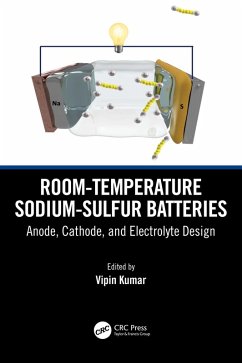Room-temperature Sodium-Sulfur Batteries (eBook, ePUB)
Anode, Cathode, and Electrolyte Design
Redaktion: Kumar, Vipin
52,95 €
52,95 €
inkl. MwSt.
Sofort per Download lieferbar

26 °P sammeln
52,95 €
Als Download kaufen

52,95 €
inkl. MwSt.
Sofort per Download lieferbar

26 °P sammeln
Jetzt verschenken
Alle Infos zum eBook verschenken
52,95 €
inkl. MwSt.
Sofort per Download lieferbar
Alle Infos zum eBook verschenken

26 °P sammeln
Room-temperature Sodium-Sulfur Batteries (eBook, ePUB)
Anode, Cathode, and Electrolyte Design
Redaktion: Kumar, Vipin
- Format: ePub
- Merkliste
- Auf die Merkliste
- Bewerten Bewerten
- Teilen
- Produkt teilen
- Produkterinnerung
- Produkterinnerung

Bitte loggen Sie sich zunächst in Ihr Kundenkonto ein oder registrieren Sie sich bei
bücher.de, um das eBook-Abo tolino select nutzen zu können.
Hier können Sie sich einloggen
Hier können Sie sich einloggen
Sie sind bereits eingeloggt. Klicken Sie auf 2. tolino select Abo, um fortzufahren.

Bitte loggen Sie sich zunächst in Ihr Kundenkonto ein oder registrieren Sie sich bei bücher.de, um das eBook-Abo tolino select nutzen zu können.
This book provides an excellent review and critical analysis of the recently demonstrated room-temperature sodium-sulfur batteries. Divided into three sections, it highlights the status of the technologies and strategies developed for the sodium metal anode, insight into the development of sulfur cathode, and electrolyte engineering.
- Geräte: eReader
- mit Kopierschutz
- eBook Hilfe
Andere Kunden interessierten sich auch für
![Room-temperature Sodium-Sulfur Batteries (eBook, PDF) Room-temperature Sodium-Sulfur Batteries (eBook, PDF)]() Room-temperature Sodium-Sulfur Batteries (eBook, PDF)52,95 €
Room-temperature Sodium-Sulfur Batteries (eBook, PDF)52,95 €![Advanced Metal Ion Storage Technologies (eBook, ePUB) Advanced Metal Ion Storage Technologies (eBook, ePUB)]() Advanced Metal Ion Storage Technologies (eBook, ePUB)52,95 €
Advanced Metal Ion Storage Technologies (eBook, ePUB)52,95 €![Microscopy and Microanalysis for Lithium-Ion Batteries (eBook, ePUB) Microscopy and Microanalysis for Lithium-Ion Batteries (eBook, ePUB)]() Microscopy and Microanalysis for Lithium-Ion Batteries (eBook, ePUB)60,95 €
Microscopy and Microanalysis for Lithium-Ion Batteries (eBook, ePUB)60,95 €![Materials for Energy Conversion and Storage (eBook, ePUB) Materials for Energy Conversion and Storage (eBook, ePUB)]() Materials for Energy Conversion and Storage (eBook, ePUB)52,95 €
Materials for Energy Conversion and Storage (eBook, ePUB)52,95 €![Advanced Materials for Sodium Ion Storage (eBook, ePUB) Advanced Materials for Sodium Ion Storage (eBook, ePUB)]() Ranjusha RajagopalanAdvanced Materials for Sodium Ion Storage (eBook, ePUB)173,95 €
Ranjusha RajagopalanAdvanced Materials for Sodium Ion Storage (eBook, ePUB)173,95 €![Advanced Technologies for Rechargeable Batteries (eBook, ePUB) Advanced Technologies for Rechargeable Batteries (eBook, ePUB)]() Advanced Technologies for Rechargeable Batteries (eBook, ePUB)173,95 €
Advanced Technologies for Rechargeable Batteries (eBook, ePUB)173,95 €![Advanced Technologies for Rechargeable Batteries (eBook, ePUB) Advanced Technologies for Rechargeable Batteries (eBook, ePUB)]() Advanced Technologies for Rechargeable Batteries (eBook, ePUB)173,95 €
Advanced Technologies for Rechargeable Batteries (eBook, ePUB)173,95 €-
-
-
This book provides an excellent review and critical analysis of the recently demonstrated room-temperature sodium-sulfur batteries. Divided into three sections, it highlights the status of the technologies and strategies developed for the sodium metal anode, insight into the development of sulfur cathode, and electrolyte engineering.
Dieser Download kann aus rechtlichen Gründen nur mit Rechnungsadresse in A, B, BG, CY, CZ, D, DK, EW, E, FIN, F, GR, HR, H, IRL, I, LT, L, LR, M, NL, PL, P, R, S, SLO, SK ausgeliefert werden.
Produktdetails
- Produktdetails
- Verlag: Taylor & Francis eBooks
- Seitenzahl: 176
- Erscheinungstermin: 8. Dezember 2023
- Englisch
- ISBN-13: 9781003803447
- Artikelnr.: 69144878
- Verlag: Taylor & Francis eBooks
- Seitenzahl: 176
- Erscheinungstermin: 8. Dezember 2023
- Englisch
- ISBN-13: 9781003803447
- Artikelnr.: 69144878
- Herstellerkennzeichnung Die Herstellerinformationen sind derzeit nicht verfügbar.
Dr. Vipin Kumar is an Assistant Professor in the Department of Energy Science and Engineering (DESE) at the Indian Institute of Technology Delhi (IIT Delhi), India. He is the coordinator of a virtual interdisciplinary school, i.e., the School of Interdisciplinary Research (SIRe) at IIT Delhi. He received his doctoral and master's degrees from Nanyang Technological University Singapore (NTU Singapore) and IIT Delhi in 2016 and 2011. He worked with the Institute of Materials Research and Engineering (IMRE), Agency for Science, Technology, and Research (A*STAR), Singapore, to develop high-energy metal-sulfur batteries. His research focuses on electrochemical energy storage devices, such as room-temperature metal-sulfur batteries (e.g., Na-S, Li-S, Al-S, and Mg-S). Most of his studies were devoted to energy-related projects. He has received several prestigious awards, including the "Inspire Faculty Award" offered by the Department of Science and Technology, India, in 2017. Since May 2020, he has been working as an Assistant Professor at the Indian Institute of Technology Delhi (IIT Delhi), India, and running his battery research group (Advanced Batteries Research Laboratory) in the Department of Energy Science and Engineering, IIT Delhi. His group currently focuses on exploring the fundamental and applied aspects of metal-sulfur batteries.
Chapter 1. Introduction: Sodium Sulfur battery technology. 1.1
Introduction: Sodium Sulfur battery technology. 1.2 Brief history of Sodium
Sulfur battery. 1.3 Sodium-metal batteries and the operation of
high-temperature Sodium-Sulfur Batteries. 1.4 The transition from
high-temperature to room-temperature sodium-sulfur Batteries. 1.5
Development of the RT Na-S batteries. 1.6 Conclusion and Prospects.
References. Chapter 2. Sodium metal anode: Past, Present, and Future of
sodium metal anode. 2.1 Introduction to the sodium metal anode. 2.2
Challenges in developing a stable sodium metal anode. 2.3 Strategies to
overcome the challenges. 2.4 Future prospects. References. Chapter 3.
Sulfur Cathode: Progress in the development of sulfur cathode. 3.1
Introduction to Sulfur Cathode. 3.2 Challenges in developing the stable
sulfur cathodes. 3.3 Progress in developing sulfur cathodes. 3.4 Importance
of electrolyte/sulfur (E/S) ratio in developing a stable sulfur cathode.
3.5 Strategies to develop high-loading sulfur cathodes. 3.6 Future
prospects. References. Chapter 4. Electrolytes for room-temperature
sodium-sulfur batteries: A holistic approach to understand solvation. 4.1
Basic properties of the electrolytes for alkali metal batteries. 4.2 The
Solid-electrolyte interphase (SEI) and the Importance of sodium-ion
solvation. 4.3 Liquid electrolyte to quasi-solid-state electrolyte to solid
electrolyte for sodium-sulfur batteries. 4.4 Nature of electrolyte and its
role in developing a stable SEI and CEI. 4.5 Future prospects. References.
Chapter 5. Analytical Techniques to Probe Room-Temperature Sodium-Sulfur
Batteries. 5.1 Introduction. 5.2 Overview of the routine techniques to
probe sodium metal anode. 5.3 Overview of the routine techniques to probe
sulfur cathode. 5.4 In-situ/Operando techniques for sodium-sulfur
batteries. 5.5 Future prospects. References. Chapter 6. Sodium sulfur
batteries: similarities and differences with Lithium-sulfur battery. 6.1.
Na-S and Li-S chemistries are fundamentally different- a mechanistic
overview. 6.2 Polysulfide Species Dissolution. 6.3 Electrolyte for Li-S and
RT Na-S batteries. 6.4 Future Prospect. References. Chapter 7. Other Sodium
Metal Based Rechargeable Battery Technologies: A Brief Introduction to
Sodium Dual Ion Batteries. 7.1 Bird-eye view of the sodium metal-based
batteries. 7.2 Overview of sodium air battery. 7.3 Overview of sodium
dual-ion batteries. 7.4 Future Prospects. References. Chapter 8. Conclusion
and Prospects.
Introduction: Sodium Sulfur battery technology. 1.2 Brief history of Sodium
Sulfur battery. 1.3 Sodium-metal batteries and the operation of
high-temperature Sodium-Sulfur Batteries. 1.4 The transition from
high-temperature to room-temperature sodium-sulfur Batteries. 1.5
Development of the RT Na-S batteries. 1.6 Conclusion and Prospects.
References. Chapter 2. Sodium metal anode: Past, Present, and Future of
sodium metal anode. 2.1 Introduction to the sodium metal anode. 2.2
Challenges in developing a stable sodium metal anode. 2.3 Strategies to
overcome the challenges. 2.4 Future prospects. References. Chapter 3.
Sulfur Cathode: Progress in the development of sulfur cathode. 3.1
Introduction to Sulfur Cathode. 3.2 Challenges in developing the stable
sulfur cathodes. 3.3 Progress in developing sulfur cathodes. 3.4 Importance
of electrolyte/sulfur (E/S) ratio in developing a stable sulfur cathode.
3.5 Strategies to develop high-loading sulfur cathodes. 3.6 Future
prospects. References. Chapter 4. Electrolytes for room-temperature
sodium-sulfur batteries: A holistic approach to understand solvation. 4.1
Basic properties of the electrolytes for alkali metal batteries. 4.2 The
Solid-electrolyte interphase (SEI) and the Importance of sodium-ion
solvation. 4.3 Liquid electrolyte to quasi-solid-state electrolyte to solid
electrolyte for sodium-sulfur batteries. 4.4 Nature of electrolyte and its
role in developing a stable SEI and CEI. 4.5 Future prospects. References.
Chapter 5. Analytical Techniques to Probe Room-Temperature Sodium-Sulfur
Batteries. 5.1 Introduction. 5.2 Overview of the routine techniques to
probe sodium metal anode. 5.3 Overview of the routine techniques to probe
sulfur cathode. 5.4 In-situ/Operando techniques for sodium-sulfur
batteries. 5.5 Future prospects. References. Chapter 6. Sodium sulfur
batteries: similarities and differences with Lithium-sulfur battery. 6.1.
Na-S and Li-S chemistries are fundamentally different- a mechanistic
overview. 6.2 Polysulfide Species Dissolution. 6.3 Electrolyte for Li-S and
RT Na-S batteries. 6.4 Future Prospect. References. Chapter 7. Other Sodium
Metal Based Rechargeable Battery Technologies: A Brief Introduction to
Sodium Dual Ion Batteries. 7.1 Bird-eye view of the sodium metal-based
batteries. 7.2 Overview of sodium air battery. 7.3 Overview of sodium
dual-ion batteries. 7.4 Future Prospects. References. Chapter 8. Conclusion
and Prospects.
Chapter 1. Introduction: Sodium Sulfur battery technology. 1.1
Introduction: Sodium Sulfur battery technology. 1.2 Brief history of Sodium
Sulfur battery. 1.3 Sodium-metal batteries and the operation of
high-temperature Sodium-Sulfur Batteries. 1.4 The transition from
high-temperature to room-temperature sodium-sulfur Batteries. 1.5
Development of the RT Na-S batteries. 1.6 Conclusion and Prospects.
References. Chapter 2. Sodium metal anode: Past, Present, and Future of
sodium metal anode. 2.1 Introduction to the sodium metal anode. 2.2
Challenges in developing a stable sodium metal anode. 2.3 Strategies to
overcome the challenges. 2.4 Future prospects. References. Chapter 3.
Sulfur Cathode: Progress in the development of sulfur cathode. 3.1
Introduction to Sulfur Cathode. 3.2 Challenges in developing the stable
sulfur cathodes. 3.3 Progress in developing sulfur cathodes. 3.4 Importance
of electrolyte/sulfur (E/S) ratio in developing a stable sulfur cathode.
3.5 Strategies to develop high-loading sulfur cathodes. 3.6 Future
prospects. References. Chapter 4. Electrolytes for room-temperature
sodium-sulfur batteries: A holistic approach to understand solvation. 4.1
Basic properties of the electrolytes for alkali metal batteries. 4.2 The
Solid-electrolyte interphase (SEI) and the Importance of sodium-ion
solvation. 4.3 Liquid electrolyte to quasi-solid-state electrolyte to solid
electrolyte for sodium-sulfur batteries. 4.4 Nature of electrolyte and its
role in developing a stable SEI and CEI. 4.5 Future prospects. References.
Chapter 5. Analytical Techniques to Probe Room-Temperature Sodium-Sulfur
Batteries. 5.1 Introduction. 5.2 Overview of the routine techniques to
probe sodium metal anode. 5.3 Overview of the routine techniques to probe
sulfur cathode. 5.4 In-situ/Operando techniques for sodium-sulfur
batteries. 5.5 Future prospects. References. Chapter 6. Sodium sulfur
batteries: similarities and differences with Lithium-sulfur battery. 6.1.
Na-S and Li-S chemistries are fundamentally different- a mechanistic
overview. 6.2 Polysulfide Species Dissolution. 6.3 Electrolyte for Li-S and
RT Na-S batteries. 6.4 Future Prospect. References. Chapter 7. Other Sodium
Metal Based Rechargeable Battery Technologies: A Brief Introduction to
Sodium Dual Ion Batteries. 7.1 Bird-eye view of the sodium metal-based
batteries. 7.2 Overview of sodium air battery. 7.3 Overview of sodium
dual-ion batteries. 7.4 Future Prospects. References. Chapter 8. Conclusion
and Prospects.
Introduction: Sodium Sulfur battery technology. 1.2 Brief history of Sodium
Sulfur battery. 1.3 Sodium-metal batteries and the operation of
high-temperature Sodium-Sulfur Batteries. 1.4 The transition from
high-temperature to room-temperature sodium-sulfur Batteries. 1.5
Development of the RT Na-S batteries. 1.6 Conclusion and Prospects.
References. Chapter 2. Sodium metal anode: Past, Present, and Future of
sodium metal anode. 2.1 Introduction to the sodium metal anode. 2.2
Challenges in developing a stable sodium metal anode. 2.3 Strategies to
overcome the challenges. 2.4 Future prospects. References. Chapter 3.
Sulfur Cathode: Progress in the development of sulfur cathode. 3.1
Introduction to Sulfur Cathode. 3.2 Challenges in developing the stable
sulfur cathodes. 3.3 Progress in developing sulfur cathodes. 3.4 Importance
of electrolyte/sulfur (E/S) ratio in developing a stable sulfur cathode.
3.5 Strategies to develop high-loading sulfur cathodes. 3.6 Future
prospects. References. Chapter 4. Electrolytes for room-temperature
sodium-sulfur batteries: A holistic approach to understand solvation. 4.1
Basic properties of the electrolytes for alkali metal batteries. 4.2 The
Solid-electrolyte interphase (SEI) and the Importance of sodium-ion
solvation. 4.3 Liquid electrolyte to quasi-solid-state electrolyte to solid
electrolyte for sodium-sulfur batteries. 4.4 Nature of electrolyte and its
role in developing a stable SEI and CEI. 4.5 Future prospects. References.
Chapter 5. Analytical Techniques to Probe Room-Temperature Sodium-Sulfur
Batteries. 5.1 Introduction. 5.2 Overview of the routine techniques to
probe sodium metal anode. 5.3 Overview of the routine techniques to probe
sulfur cathode. 5.4 In-situ/Operando techniques for sodium-sulfur
batteries. 5.5 Future prospects. References. Chapter 6. Sodium sulfur
batteries: similarities and differences with Lithium-sulfur battery. 6.1.
Na-S and Li-S chemistries are fundamentally different- a mechanistic
overview. 6.2 Polysulfide Species Dissolution. 6.3 Electrolyte for Li-S and
RT Na-S batteries. 6.4 Future Prospect. References. Chapter 7. Other Sodium
Metal Based Rechargeable Battery Technologies: A Brief Introduction to
Sodium Dual Ion Batteries. 7.1 Bird-eye view of the sodium metal-based
batteries. 7.2 Overview of sodium air battery. 7.3 Overview of sodium
dual-ion batteries. 7.4 Future Prospects. References. Chapter 8. Conclusion
and Prospects.







